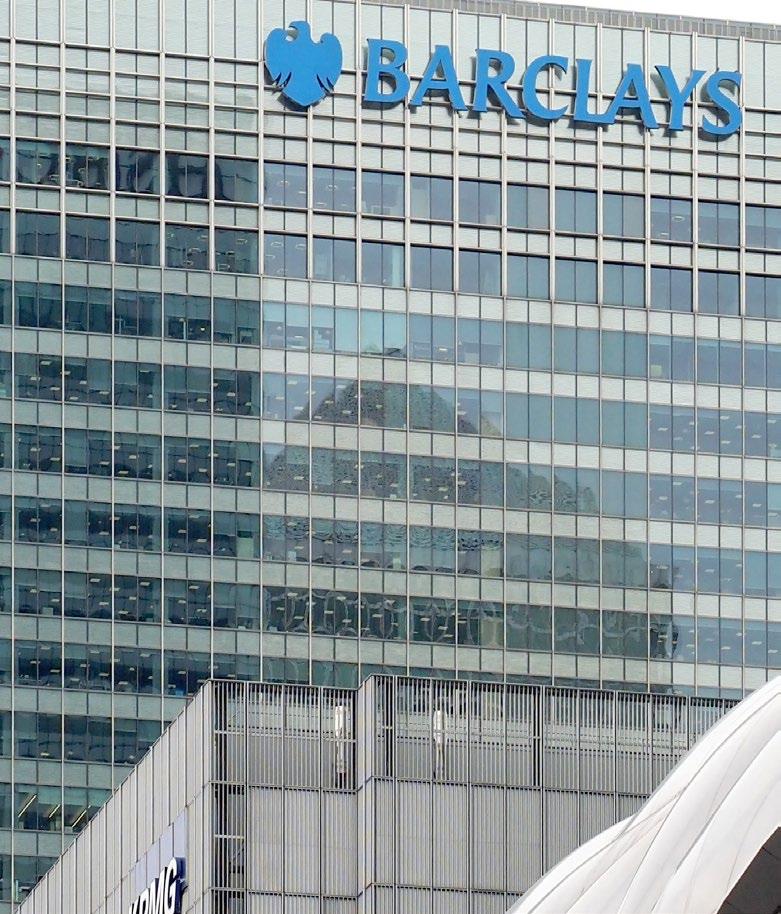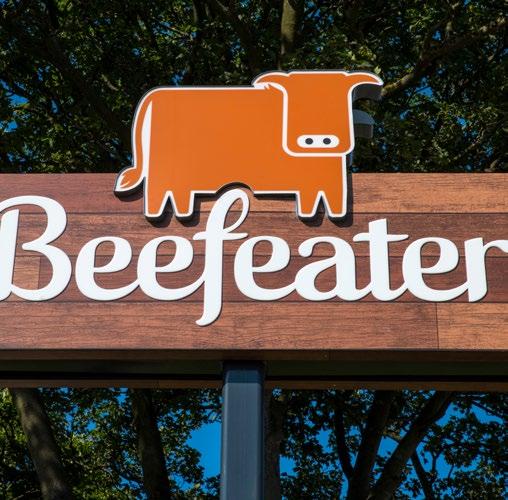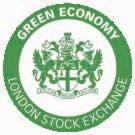TESLA AT A CROSSROADS

CAN CONCERTED MOVE INTO MASS MARKET RECHARGE THE SHARES?
VOL 26 / ISSUE 17 / 02 MAY 2024 / £4.49

Your call may be recorded for training or monitoring purposes. Issued and approved by Baillie Gifford & Co Limited, whose registered address is at Calton Square, 1 Greenside Row, Edinburgh, EH1 3AN, United Kingdom. Baillie Gifford & Co Limited is the authorised Alternative Investment Fund Manager and Company Secretary of the Trust. Baillie Gifford & Co Limited is authorised and regulated by the Financial Conduct Authority (FCA). The investment trusts managed by Baillie Gifford & Co Limited are listed UK companies and are not authorised or regulated by the Financial Conduct Authority. The Monks Investment Trust In a world of twists and turns, you need to look at growth in three dimensions.
1929, the Monks Investment Trust’s mission has been to grow wealth for our investors whatever has been going on in the world. Today our active managers aim to do this by looking at growth in three dimensions: Growth
established, reliable businesses. Rapid Growth: companies aiming for impressive growth in the future. Cyclical Growth: businesses whose growth cycle has come round again. Capital at risk.
out more by visiting monksinvestmenttrust.co.uk A Key Information Document is available. Call 0800 917 2112.
Since
Stalwarts:
Find
06 Alphabet joins Meta in shareholder dividend commitment 07 Stagflation fears rise on turgid US economy and sticky core inflation
08 What is happening at Smithson after continuation vote dissent?
09 Barclays breaks to 52-week high despite lower earnings 09 Shoe Zone shares slump on fears over trading and higher costs
1 1 What will investors want from BP’s first-quarter results?
1 2 Disney theme parks and subscriber numbers at the forefront when the entertainment giant reports
1 4 No change expected in Fed policy after data throws up more mixed messages
1 6 Market share gains and dividend growth are on the menu at Premier Foods
1 8 Take advantage of Scottish American’s discount to NAV to pick up quality companies on the cheap UPDATES
19 Whitbread re-rating yet to materialise despite clear progress
21 Would UK companies get a higher rating by moving their listing to the US?
COVER STORY Tesla at a crossroads Can concerted move into mass market recharge the shares?
UNDER THE BONNET Discover the secrets behind Danaher’s huge



02 May 2024 | SHARES | 03 Contents
NEWS
GREAT IDEAS
FEATURES
26
31
success story 35 SECTOR REPORT
can
recovery 40 PERSONAL FINANCE How to use ‘refer
deals to boost your savings 42 RUSS MOULD Why
finally finding some friends 44 EDITOR’S VIEW
to the markets? 46 ASK RACHEL
pension withdrawal? 48 INDEX Shares, funds, ETFs and investment trusts in this issue 40 31 2 6 46
Understand the chemicals sector and whether 2024
see a
a friend’
the FTSE 100 is
Are we back in 1995 when it comes
Can I avoid emergency tax on a
Three important things in this week’s magazine




Visit our website for more articles
Did you know that we publish daily news stories on our website as bonus content? These articles do not appear in the magazine so make sure you keep abreast of market activities by visiting our website on a regular basis.
Over the past week we’ve written a variety of news stories online that do not appear in this magazine, including:




04 | SHARES 02 May 2024 Contents
22 SHARES 02 May2024 Feature: UK vs US market The way to achieve a better return for shareholders may lie closer to home I n the last few weeks, the drumbeat of companies complaining about the lowly valuation of their shares and floating the idea of moving to the US market has grown steadily louder. First there was miner Glencore (GLEN), then oil major Shell (SHEL) started making noises and most recently online retailer Ocado (OCDO) has come under shareholder pressure to move its listing. What is significant is these aren’t diddy AIMlisted businesses who are contemplating throwing in the towel (although plenty are) – all three are FTSE 100 companies, and if any or all of them decide to move their main listing to the US then a whole swathe of companies could follow suit. The question is, why are they so keen to move to the US and what good will it do shareholders? POTENTIAL LEAVERS Last year, mining group Glencore acquired a majority stake in a coal business previously owned by Canadian firm Teck Resources (TECK.B:TSE) with the aim of combining it with its own coal operations and listing the business in New York. The rationale for listing there rather than here is US investors are more open to investing in fossil fuels than investors in Europe, where around half of mutual funds don’t own coal assets due to their ESG (environmental, social and governance) guidelines. Would UK companies get a higher rating by moving their listing to the US? However, some shareholders are seen opposing listing the business in the US, in which case the company might consider moving its main listing to the US in order to benefit from the higher rating afforded to commodity stocks, according to analysts. Irish cement group CRH (CRH) shifted its primary quote from London to New York last year on the basis the US is a huge market for its products, and investors have been richly rewarded with a 60% rally in the shares helped by strong earnings upgrades. In 2022, mining group BHP (BHP) switched its primary listing from London to Sydney given most of the trading in its shares already happened in Australia. Meanwhile, both the current and former chief executives of oil giant Shell, the largest company in the FTSE 100 by market cap, have talked about the advantages of moving the firm’s main listing to the US. In an interview with Bloomberg, chief executive Wael Sawan pinned the valuation gap between his firm and US-listed rivals Exxon Mobil (XOM:NYSE) ConocoPhillips (COP:NYSE) and Chevron (CVX:NYSE) on the fact Shell has ‘a location that clearly seems to be undervalued’. Sawan’s priority for now is to improve returns over what he calls a ‘sprint’ of 10 quarters, buying back shares in the meantime, but ‘if we work 30 | SHARES 02 May2024 Under the Bonnet: Danaher This could be one of the best companies you have never heard of USbiotechnology, life sciences and diagnostics company Danaher (DHR:NYSE) is one of the most successful companies to list on the New York Stock Exchange that few people outside the US have heard of. This feature peeks under the bonnet to see how the company has achieved its success and explores itsStevenprospects. and Mitchell Rales and a group of investors acquired a struggling conglomerate in the 1980s and renamed it Danaher Corp. A $1,000 investment in Danaher in 1984 would today be worth around $1.8 million excluding reinvested dividends. That is equivalent to a CAGR (compound annual growth rate) of 21% a year. To put that into context Warren Buffett’s Berkshire Hathaway (BRK- B:NYSE) has delivered a CAGR of 17% a year over the same period. A lot can change over 40 years, yet interestingly one aspect of Danaher has not changed in that time. The brothers originally envisioned building a company with a focus on continuous improvement and customer satisfaction. The idea was inspired by the Japanese business philosophy of Kaizen which means change for the better. HOW HAS THE BUSINESS EVOLVE? Today the DBS (Danaher Business System) sits at the core of the company’s operations and strategic focus. Before describing the business in more detail, it is worth looking back to see how it evolved. The Rales brothers originally established a group of manufacturing businesses with a view to improving them and extracting value. From the early 1990s the company started to organise around strategic platforms with sustainable competitive advantages and structural growth drivers. Over the next few decades Danaher built leadership positions in the science and technology sectors which define the company today. Strategic acquisitions have played a key role in expanding and broadening Danaher’s reach and capabilities. For example, in 2012 Danaher purchased Kiva Systems, a robotics company which has helped drive efficiency and productivity at Amazon’s (AMZN:NASDAQ) fulfilment centres worldwide.Management believes DBS is at the heart of the company’s success. It nurtures innovation, reduces time to market and delivers ground-breaking products and solutions. WHAT IS THE SHAPE OF THE OVERALL BUSINESS TODAY? The company is organised under three platforms or divisions which house companies operating in their own niche. The largest is diagnostics which contributed 44% of revenue and 64% of group operating profit respectively in the first quarter of 2024. Discover the secrets behind Danaher’s huge success story DANAHER Fast facts Ticker: DHR:NYSE Share price: $253 Market cap: £141.5 billion TESLA
CROSSROADSA CAN CONCERTED MOVE INTO MASS MARKET RECHARGE THE SHARES? By Steven Frazer News Editor Samsung profits surge 10-fold in first quarter thanks to AI boom Card Factory rallies 6% as dividend reinstatement demonstrates confidence HSBC shares hit new high as earnings and buyback beat forecasts AstraZeneca shares up after breast cancer drug shows positive results 1 2 3 Telsa at a crossroads Looking at whether the wellreceived plan for mass market vehicles can recharge the EV maker’s share price. A US listing may not be a panacea for UK companies
to why some Londonlisted firms trade at a discount may lay closer to home. The best company you may never have heard of Find out more about Danaher and how it has delivered such extraordinary returns over time.
AT
Answers
To be ahead in Asia, be on the ground.
abrdn Asian Investment Trusts
In Asia, life and business move fast. To invest here successfully, you need local knowledge.
abrdn has had investment teams in Asia for over 40 years. So we get to know markets, companies, trends and innovations first hand. And you get to select from investment trusts featuring the most compelling Asia opportunities we can find.
To harness the full potential of Asia, explore our Asian investment trusts on our website.
Please remember, the value of shares and the income from them can go down as well as up and you may get back less than the amount invested. Asian funds may invest in emerging markets which can carry more risk than developed markets.

Issued by abrdn Fund Managers Limited, registered in England and Wales (740118) at 280 Bishopsgate, London, EC2M 4AG. Authorised and regulated by the Financial Conduct Authority in the UK. Please quote Q206. Find out more at abrdn.com/asiatrusts Invest via most leading platforms.
Alphabet joins Meta in shareholder dividend commitment
Five of ‘Magnificent Seven’ to make quarterly payout to investors
Google-owner Alphabet (GOOG:NASDAQ) shocked the market with a first-quarter announcement that it plans to kick-start regular quarterly dividends. In February 2024, Meta Platforms (META:NASDAQ) made headlines with its own dividend announcement, joining Apple (AAPL:NASDAQ), Microsoft (MSFT:NASDAQ) and Nvidia (NVDA:NASDAQ) in committing to quarterly shareholder payouts, and Alphabet’s move means five of the so-called ‘Magnificent Seven’ big tech stocks will pay dividends in future.
Alphabet’s initial $0.20 per share payout implies a tiny yield of just 0.2%, but there is scope for rapid payout growth in future. It will leave just Amazon (AMZN:NASDAQ) and Tesla (TSLA:NASDAQ) of the seven without any commitment to dividends.
February, it helped send shares soaring more than 14%. The response to Alphabet’s plans was similar, sending the stock surging around 10% to register an all-time of $173.69 (26 April).

It marks a major transition for big tech as their respective businesses mature, with major job layoffs and tightened spending plans having been pushed through since 2022.
Every major tech firm announced layoffs and tightened spending beginning in 2022. Investors rewarded those efforts and have shown a similar reaction to share buybacks and dividend initiations. When Meta announced its first ever dividend in
As with Meta, Alphabet has previously returned cash to shareholders via hefty share repurchases. In 2023, the internet search giant spent $61.5 billion on share buybacks as profits rose. But changes to US corporate tax rules may be a factor in big tech rebalancing shareholders returns towards dividends and away from share buybacks. Buybacks now incur a 1% tax as the US government continues to grapple with its budget deficit. This could rise to 4% if changes proposed last year are pushed through. However, Alphabet’s announcement that it also plans to buyback up to $70 billion worth of stock going forward suggests this line of thought may be less meaningful than answering the simple question of what to do with the enormous amounts of cash sitting idle on major tech firms’ balance sheets. According to Stockopedia data, Alphabet, Apple, Meta, Microsoft and Nvidia have more than $345 billion of cash on deposit.
Putting this monumental capital to work is not easy given the reluctance of regulators to allow major tech firms to pursue significant acquisition strategies for fear of unfairly tilting the competition scales away from smaller tech firms. [SF]
2023's monumental big tech share buybacks ($bn)
News 06 | SHARES | 02 May 2024
Apple Alphabet Meta Platforms Microsoft Nvidia 77.6 61.5 20.7 18.1 8.09 Chart: Shares magazine • Source: Company accounts
Stagflation fears rise on turgid US economy and sticky core inflation
A strong US dollar is increasing tension in currency markets
With around 40% of S&P 500 constituents reporting earnings last week including heavyweights Microsoft (MSFT:NASDAQ) and Alphabet (GOOG:NASDAQ), the micro picture was widely expected to be the main investor focus.
As things turned out, a surprisingly weak first quarter GDP (gross domestic product) print and higher-than-anticipated March inflation gave investors and the Federal Reserve further pause for thought on the likely path for inflation and interest rates.
For the first time in a few months, the dreaded phrase ‘stagflation’ began to be uttered in some corners of the market.
Fitch Ratings head of research Olu Sonola said: ‘If growth continues to slowly decelerate, but inflation strongly takes off again in the wrong direction, the expectation of a Fed interest rate cut in 2024 is starting to look increasingly out of reach.’
Market implied cumulative rate cuts in 2024 have
been slashed from 1.5% in January to just 0.35%.
The US economy grew at an annualised 1.6% rate in the three months to March compared with the 3.4% rate seen in the final quarter of 2023 and well below economists’ forecasts of 2.4%.
A closer inspection suggests the message of a slowing economy is not as clear cut as the headline numbers first suggest: slower federal government spending and inventories acted as a drag on GDP, as did foreign trade.
Stripping out these effects, underlying demand as measured by inflation-adjusted final sales to the private sector rose at an annualised 3.1% rate. Spending on services increased by the most since the third quarter of 2021 as healthcare and financial services-fuelled growth.
Meanwhile, core PCE (personal consumption expenditures), the Federal Reserve’s preferred measure of inflation, jumped at a 2.8% annualised rate in March driven by a larger-than-expected 0.5% increase in inflation-adjusted consumer spending.
A consequence of US resilience and a Fed on hold is playing out in currency markets as the US dollar is buoyed by diverging central bank interest-rate policies.
The Japanese yen weakened to its lowest level since 1990 on 29 April, after briefly surpassing ¥160 before retreating to ¥156 on suspected intervention by the Bank of Japan.
A weak yen makes imports of food and other products more expensive and potentially increases domestic inflation. Last week, finance minister Shunichi Suzuki said he was concerned about the impact a falling yen could have on inflation. The currency has dropped by around a tenth so far in 2024. [MG]
News 02 May 2024 | SHARES | 07
Japanese yen to US dollar (¥) 1990 1995 2000 2005 2010 2015 2020 80 100 120 140 Chart: Shares magazine • Source: LSEG
What is happening at Smithson after continuation vote dissent?
The investment trust has irked investors with its approach
Investment trust Smithson (SSON) has work to do to repair its relationship with shareholders after recent controversy over a continuation vote at the stablemate of Terry Smith’s Fundsmith Equity (B41YBW7).
Smithson, which looks to apply Smith’s ‘buy good companies, don’t overpay, do nothing’ approach to small- and mid-cap companies, had said to investors at its inception it would consider holding a vote on its future if the trust’s average discount to NAV (net asset value) in any individual year was greater than 10%. In 2023 the average discount was 10.7% amid patchy recent performance.
However, in the trust’s annual report released 27 February chair Diana Dyer Bartlett said there would be no such vote. The reasoning given was the discount related to broader market conditions rather than being specific to the trust, with previous strong performance flagged alongside the board’s confidence in future prospects.
This created a real stink with Peter Spiller of Capital Gearing Trust (CGT), which holds Smithson, saying he was ‘horrified’ and pledging to vote against Dyer Bartlett’s re-election. The backlash prompted a U-turn and a vote was held at the AGM (annual general meeting) on 25 April.
The result saw 9.6% of votes cast against continuation and 19.2% against the re-election of Dyer Bartlett, with 10.2% of votes also cast against the re-appointment of Lord St John of Bletso as chair of the audit committee.
Numis describes the debacle as a ‘corporate governance own goal’ but also says: ‘We believe positive lessons have been learnt by the manager. The manager now has more willingness to sell if there are early warning signs that the business case may not be playing out, and to take profits on valuation grounds.
‘We believe this approach is more pragmatic and reduces the risk of inertia leaving the portfolio skewed to very expensive stocks, whilst the manager’s mantra is likely to ensure turnover

remains low. We believe that the portfolio has sound fundamentals that place it in a strong position to outperform over the long run.’ [TS]
WHAT IS A CONTINUATION VOTE?
IT’S QUITE COMMON for trusts to have a provision in their Articles of Association for a continuation vote every three or five years, to determine whether said trust should continue as normal or liquidate its assets and wind down. Some trusts have ‘conditional triggers’ which require or prompt them to hold a continuation vote if, say, their market value falls below a certain level or the discount to NAV is persistently wide.
News 08 | SHARES | 02 May 2024
(p) 2019 2020 2021 2022 2023 2024 1,000 1,500 2,000 Chart: Shares magazine • Source: LSEG
Smithson
Barclays breaks to 52-week high despite lower earnings
The bank reaffirmed its plan to return over a third of its market cap to shareholders
It has been a while since investors in UK banks had cause to celebrate but shareholders in Barclays (BARC) were toasting a small win last week as the high-street lender posted first-quarter profit above market expectations, sending its shares to new 12-month high of 200p.
The core UK retail business saw net interest income dip 4% to £1.55 billion as customers borrowed less and depositholders shifted their money into higher-earning accounts, but credit quality
remains healthy for now so the bank only took £58 million of provisions for bad loans against nearly double that amount in the same period last year.
Barclays’ investment bank had a weak quarter compared with the likes of Goldman Sachs (GS:NYSE) and JPMorgan (JPM:NYSE), posting a 7% drop in income due to lower activity in its fixed-income and commodities business, but overall investors seemed happy with the results.
Chief executive C.S. Venkatakrishnan was keen to draw attention to the bank’s success in raising its return on tangible equity
Shoe Zone shares slump on fears over trading and higher costs

It has been a turbulent couple of months for value retailer Shoe Zone (SHOE), which seems to have metamorphosed from cost-of-living-crisis winner to stock market pariah on the strength of a single comment by chief executive Anthony Smith.
In the firm’s extremely brief AGM statement in midMarch, Smith celebrated a successful year of growth in 2023 while cautioning current-year trading was ‘marginally’ below company
expectations due to issues with shipping through the Suez Canal, higher costs associated with store upgrades and a slower than anticipated end to the Autumn/Winter season.
Bearing in mind the firm is in the middle of transforming its estate into ‘big box’ and hybrid formats, which generate higher sales than its old stores, and it expects product margins to increase due to lower container costs and canny buying, ‘marginally’ lower trading is far from disastrous.
And, as Next (NXT) and Primark have shown,

to above its medium-term target of 12%, and reiterated the bank’s target of returning at least £10 billion to shareholders between 2024 and 2026, or more than one third of its current market cap, through dividends and buybacks. [IC]
consumers are prioritising spending on good-value essentials like clothing and footwear rather than nice-to-have products like watches and jewellery, which plays directly to Shoe Zone’s strengths.
The firm is due to publish its interim results for the period to March in three weeks’ time (21 May) and Shares for one will be keen to see what the firm has to say. [IC]
News 02 May 2024 | SHARES | 09
Unguarded
a
DOWN in the dumps HIGHER Moving
comment in
press release sends stock price tumbling
Barclays (p) Jan 2024 Apr 150 200 Chart: Sharesmagazine • Source: LSEG Shoe Zone (p) Feb 2024 Mar Apr 200 250 Chart: Sharesmagazine • Source: LSEG

There’s no better investment return than the freedom to live well Whatever your financial goals, a Janus Henderson Investment Trust invests for your future actively, expertly and diligently. Whether you’re looking for growth or a steady income, our range of trusts aims for competitive returns across a diverse selection of global investments. And with decades of investment trust experience behind us, you can look forward with confidence. Explore our Investment Trust range at www.janushenderson.com/JHIT INVESTMENT TRUSTS Marketing communication. Not for onward distribution. The value of an investment and the income from it can fall as well as rise and you may not get back the amount originally invested. Not for distribution in European Union Member countries. Issued in the UK by Janus Henderson Investors. Janus Henderson Investors is the name under which investment products and services are provided by Janus Henderson Investors International Limited (reg. no. 3594615), Janus Henderson Investors UK Limited (reg. no. 906355), Janus Henderson Fund Management UK Limited (reg. no. 2678531), (each registered in England and Wales at 201 Bishopsgate, London EC2M 3AE and regulated by the Financial Conduct Authority) and Janus Henderson Investors Europe S.A. (reg. no. B22848 at 2 Rue de Bitbourg, L-1273, Luxembourg and regulated by the Commission de Surveillance du Secteur Financier). Janus Henderson is a trademark of Janus Henderson Group plc or one of its subsidiaries. © Janus Henderson Group plc
3 May: Trainline
7 May: Arecor Therapeutics, Ebiquity
8 May: Alliance Pharma, Brighton Pier, Cornerstone FS
9 May: Airtel Africa

3 May: InterContinental Hotels, Mondi
7 May: BP, IWG
8 May: OSB, Renishaw
9 May: Balfour Beatty, Wheaton Precious Metals, Wood Group


What will investors want from BP’s first-quarter results?
Operational progress and shareholder returns among the areas in focus
Since BP (BP.) reported its full-year results on 6 February, events in the Middle East have helped drive Brent crude oil prices higher to bubble around the $90 per barrel mark.
While this has already provided a boost to BP’s share price, it is only likely to have affected the last few weeks of the first-quarter trading period which BP will be reporting on when it updates the market on 7 May.
Investors will want to see evidence of further operational improvements after progress on this front in the last three months of 2023 helped lift cash flow to $9.4 billion. BP, like its UK counterpart Shell (SHEL), is looking to play catch-up with US rivals which have opened up a meaningful valuation gap in recent years.
Looking ahead at 2024, Berenberg analyst Henry Tarr says: ‘The company expects higher upstream production, along with growth in convenience and Castrol within C&P (customers & products). Refining margins are
expected to be lower with realised margins affected by narrow American heavy crude differentials. Lower gas and liquefied natural gas prices will likely also be headwinds for the group in 2024.’
BP has committed to a $3.5 billion buyback for the first half of 2024 and its plan to return at least 80% of surplus cash flow to shareholders (up from 60%) could lead to positive news on dividends. [TS]
News: Week Ahead 02 May 2024 | SHARES | 11
FULL-YEAR RESULTS
UK UPDATES OVER T HE NEXT 7 DAYS
TRADING
ANNOUNCEMENTS
What the market expects of BP 2024 84.4p £218.8bn 2025 92.8p £207.8bn EPS Revenue Table: Shares magazine • Source: Stockopedia What the market expects of BP 2024 84.4p £218.8bn 2025 92.8p £207.8bn EPS Revenue Table: Shares magazine • Source: Stockopedia BP (p) Jul 2023 Oct Jan 2024 Apr 450 500 550 Chart: Shares magazine • Source: LSEG
Disney theme parks and subscriber numbers at the forefront when the entertainment giant reports
CEO Bob Iger hopes to quieten activist noise with second
Walt Disney (DIS: NYSE) is due to report second quarter earnings on 7 May.
Analysts expect the House of Mouse to deliver revenue of revenue to come in at $22.11 billion for the quarter and EPS (earnings per share) of $1.09.
Disney reported stronger-thanexpected first quarter earnings back in February boosted by cost cutting and revenue from the entertainment giant’s theme parks.
Revenues for Disney Parks and Experiences were up 13% in the first quarter to $8.3 billion and segment operating income increased 11% to $2.4 billion.
The company is hoping a for a repeat performance as well as higher attendance and spending at its international parks and resorts in Shanghai and Hong Kong.
All eyes will also be on Disney’s streaming business which has been under pressure due to increased competition and price hikes. Over

quarter earnings
What the market expects of Walt Disney
US UPDATES OVER THE NEXT 7 DAYS

QUARTERLY RESULTS
3 May: Hershey
6 May: Vertex, Simon Property, Loews
7 May: Arista Networks, Electronic Arts, McKesson, Occidental, Walt Disney
the previous quarter, the Disney+ subscriber base fell by 1.3 million. With the latest set of earnings, Disney CEO Bob Iger is probably once and for all looking to silence activist investors like Nelson Peltz who failed to get a seat on the board of directors at the company's AGM in early April.
Peltz wanted to shake up Disney and prioritise cost cutting, making the streaming operations profitable, improving the quality of output from its film studios and finding a successor to Iger. [SG]
8 May: Airbnb, Emerson, Fox Corp, News Corp, Uber Tech
9 May: Constellation Energy, Warner Bros Discovery


News: Week Ahead 12 | SHARES | 02 May 2024
Q1 forecast $1.09
EPS Revenue Table: Shares magazine • Source: Zacks Walt Disney ($) Jul 2023 Oct Jan 2024 Apr 80 100 120 Chart: Shares magazine • Source: LSEG
$22.11bn

Sophisticated global investing made effortless
Since 1888, The Bankers Investment Trust has enabled people to access a wide range of quality global investments in one expertly blended portfolio. Targeting long-term growth and income, for those aiming to invest for their future. Enjoy sophisticated investing made available to everyone at www.janushenderson.com/BNKR BANKERS INVESTMENT TRUST Marketing communication. Not for onward distribution. The value of an investment and the income from it can fall as well as rise and you may not get back the amount originally invested. Not for distribution in European Union Member countries. Issued in the UK by Janus Henderson Investors. Janus Henderson Investors is the name under which investment products and services are provided by Janus Henderson Investors International Limited (reg. no. 3594615), Janus Henderson Investors UK Limited (reg. no. 906355), Janus Henderson Fund Management UK Limited (reg. no. 2678531), (each registered in England and Wales at 201 Bishopsgate, London EC2M 3AE and regulated by the Financial Conduct Authority) and Janus Henderson Investors Europe S.A. (reg. no. B22848 at 2 Rue de Bitbourg, L-1273, Luxembourg and regulated by the Commission de Surveillance du Secteur Financier). Janus Henderson is a trademark of Janus Henderson Group plc or one of its subsidiaries. © Janus Henderson Group plc
No change expected in Fed policy after data throws up more mixed messages
UK consumption and housing market in focus in the coming days
While the market’s focus moved on to US company earnings last week, spurring a strong rebound, investors received another reality check in the form of the first-quarter GDP and core PCE (personal consumption expenditure) figures.
GDP grew at the slowest rate in two years while the PCE came in sticky as expected, presenting the Federal Reserve with an unwelcome combination as it prepares to meet for two days on Tuesday and Wednesday as Shares goes to press.
Confusing matters further, while the annualised GDP growth figure of 1.6% disappointed the market, which was primed for a 2.1% increase, consumption of services was the strongest since
Macro diary 2 May to 8 May 2024

the first half of 2021 and service-sector inflation is one of the Fed’s major bugbears.
Also before Shares goes to print are the US JOLTS (job openings) figures, which are an important guide to the strength of the labour market, as well as the so-called ‘quit rate’ which shows how easy it is for workers to find better jobs at higher wages.
Sticking with US economic data, the week ends with non-farm payrolls which have been a source of stock market volatility in previous months.
There is also a swathe of service-sector PMIs with the UK, the US and Europe all expected show continued expansion, while the focus in the coming week will be on a round of UK house price surveys, which seem to be pointing upwards again, and retail sales statistics which last time surprised to the upside. [IC]
Next Central Bank Meetings & Current
News: Week Ahead 14 | SHARES | 02 May 2024
02-May UK Nationwide April House Prices 1.6% US April Challenger Job Cuts 90.3k 03-May UK April Services PMI 53.1 US April Services PMI 51.7 US April Non-Farm Payrolls 303k 06-May Eurozone April Services PMI 52.9 UK April BRC Retail Sales Monitor 3.2% 07-May UK April Halifax House Prices 0.3% 08-May UK April RICS House Price Balance -4.0% Date Economic Event Previous Table: Shares magazine • Source: Morningstar, central bank websites
Interest Rates 09-May Bank of England 5.3% 22-May European Central Bank 4.00% 11-Jun US Federal Reserve 5.5% Date Event Previous Table: Shares magazine • Source: Morningstar, central bank websites

Looking for the comfort of growing income? There’s a wider world of investment income opportunities beyond the UK. With a broader perspective, Henderson International Income Trust invests in established leading businesses around the world. Helping investors access and enjoy the potential for consistent and growing income. Explore a world of income from the comfort of one investment at www.janushenderson.com/HINT HENDERSON INTERNATIONAL INCOME TRUST Marketing communication. Not for onward distribution. The value of an investment and the income from it can fall as well as rise and you may not get back the amount originally invested. Not for distribution in European Union Member countries. Issued in the UK by Janus Henderson Investors. Janus Henderson Investors is the name under which investment products and services are provided by Janus Henderson Investors International Limited (reg. no. 3594615), Janus Henderson Investors UK Limited (reg. no. 906355), Janus Henderson Fund Management UK Limited (reg. no. 2678531), (each registered in England and Wales at 201 Bishopsgate, London EC2M 3AE and regulated by the Financial Conduct Authority) and Janus Henderson Investors Europe S.A. (reg. no. B22848 at 2 Rue de Bitbourg, L-1273, Luxembourg and regulated by the Commission de Surveillance du Secteur Financier). Janus Henderson is a trademark of Janus Henderson Group plc or one of its subsidiaries. © Janus Henderson Group plc
Market share gains and dividend growth are on the menu at Premier Foods
The branded food group’s attractive free cash flow is likely to be seized on by investors
Premier Foods (PFD) 159.6p
Market cap: £1.39 billion
Ownership of some of Britain’s best-loved brands including Mr. Kipling, Batchelors and Bisto, appetising growth potential and a transformed financial position that should support double-digit dividend growth are reasons to buy cooking sauces, cakes and custards maker Premier Foods (PFD).
Admittedly, the stock has already rallied 350% over the past five years to reflect an impressive turnaround and balance sheet rehabilitation under CEO Alex Whitehouse, yet the shares remain attractively valued and falling debt levels combined with forecast upgrades should offer a


The company observes it is well on track to deliver against its previously raised profit expectations”
powerful re-rating catalyst. Shares believes further upwards earnings revisions could be on the menu, potentially as early as the full-year results (16 May), driven by domestic market share gains, growth in the US and Australia and a tailwind from an improving consumer backdrop.
RECIPE
FOR SUCCESS
Guided by Whitehouse and CFO Duncan Leggett, Premier Foods is one of Britain’s biggest food producers and the owner of well-loved brands including Mr. Kipling, Ambrosia, Oxo, Paxo, Sharwood’s and Lloyd Grossman, which form great components of affordable meals.
In fact, over 90% of UK households buy one or more of Premier Foods’ products every year, giving the FTSE 250 constituent’s earnings a resilient bent, while management believes three brands
Great Ideas: Investments to make today 16 | SHARES | 02 May 2024
Premier
(p) 2020 2021 2022 2023 2024 0 50 100 150 Chart: Shares magazine • Source: LSEG Premier Foods' improving financial profile 2023 (A) 137 274 1.4 2024 (F) 152 253 1.7 2025 (F) 160 161 2.1 2026 (F) 168 58 2.5 Year to March Adjusted pre-tax profit (£m) Net debt (£m) DPS (p) DPS = dividend per share Table: Shares magazine • Source: Shore Capital
Foods
Net debt to adjusted EBITDA

have global potential, namely Mr. Kipling, cooking sauce brand Sharwood’s and The Spice Tailor, a fast-growing Asian ingredients label bought in 2022 which marked Premier’s first acquisition in 15 years.
This deal was followed by 2023’s takeover of FUEL10K, a granola, oats and drinks products business which boosted the group’s position in the breakfast category, building on the success of its Ambrosia porridge pots.
Premier Foods’ shares trade on an undemanding prospective PE (price to earnings) ratio of 11.2 which implies re-rating scope”
The £1.39 billion cap also issued an upbeat outlook statement, insisting it continued to trade strongly, delivering further progress against its strategy backed by by another quarter of doubledigit sales growth and market share gains. Now into the final quarter of its financial year, the company observes it is well on track to deliver against its previously raised profit expectations, commentary which implies potential for further upwards forecast revisions in the months ahead.


Over the past decade, Hertfordshireheadquartered Premier Foods has undertaken considerable heavy lifting in rebuilding its balance sheet and reducing onerous cash commitments to debt holders and pension schemes. This has allowed it to invest behind its brands and deliver consistent growth and a cycle of forecast upgrades.
In the third quarter to 30 December 2023, Premier Foods cooked up a 14.4% rise in group sales as the international business had another very good quarter and sales in new categories more than doubled, with Ambrosia Porridge pots and Mr. Kipling and Angel Delight ice-cream both proving standout performers.
Mr Kipling market share progression in Australia
DIVIDEND GROWTH ON THE MENU
On 6 March 2024, Premier Foods announced it had struck an agreement with the RHM Pension Scheme Trustee to suspend pension deficit payments from 1 April 2024. The suspension will save Premier Foods £33 million in cash contributions in the year ending 29 March 2025 and deliver a healthy boost to its already attractive free cash flows. This can support targeted acquisitions, accelerated capital investment to drive growth as well as a progressive dividend; Premier Foods returned to the dividend list in 2021 with a modest distribution after a 13-year absence.
With debt continuing to reduce, Shore Capital forecasts a jump in pre-tax profits from £152.3 million to £160.3 million for the year to March 2025, which translates into EPS (earnings per share) of 13.6p and a 2.1p dividend that is 6.5 times covered by earnings. The broker’s estimates for full-year 2026 point to pre-tax profits of £168.3 million, EPS of 14.3p and a 20% increase in the shareholder reward to 2.5p.

Based on 2026 estimates which look conservative, Premier Foods’ shares trade on an undemanding prospective PE (price to earnings) ratio of 11.2 which implies re-rating scope. And if this undervaluation persists, Premier Foods, which fended off a bid from US spices-to-condiments company McCormick (MKC:NYSE) back in 2016, could once again become the subject of takeover interest. [JC]
Great Ideas: Investments to make today 02 May 2024 | SHARES | 17
FY19/20 FY20/21 FY21/22 FY22/23 3.2 2.8 2 1.7 1.5
FY18/19
Chart: Shares magazine • Source: Premier Foods, EBITDA = earnings before interest, tax, depreciation and amortisation
FY18/19 FY19/20 FY20/21 FY21/22 FY22/23 4.1% 6.8% 8.8% 10.2% Chart:
Shares magazine • Source: Premier Foods
Take advantage of Scottish American’s discount to NAV to pick up quality companies on the cheap
2023 saw the trust deliver its 50th consecutive dividend increase
Scottish American Investment Company (SAIN) 503p
Market cap: £898 million
Ballie Gifford-managed Scottish American (SAIN), also referred to as ‘SAINTS’, is trading at an 8% discount to net asset value which offers a great opportunity to buy high-quality assets on the cheap.
The fund is steered by co-managers James Dow and Ross Mathison, after Toby Ross stepped away from co-managing the fund in February.
The managers are focused on finding and investing in steady, long-term compounders which throw off sustainable, resilient dividends.
The trust was founded in 1873 to seek higher income outside the UK and has grown its dividend for 50 consecutive years. The last time the dividend was cut was 1938, before the Second World War.
Over the last decade, the trust has grown its dividend at an annualised rate of 3.3% per year, which is ahead of UK price inflation as measured by consumer prices, which has annualised at 2.9% per year.
The team believe dividend growth is closely associated with compounding and enhances investment returns.
The manager’s approach is similar in style to investment legend Warren Buffett and Fundsmith founder Terry Smith. SAINTS likens compounding to the effect of a snowball rolling down a long hill: the further it travels, the faster it gains in size.
American
Chart: Shares magazine•Source: LSEG
return of 218.2%.
The portfolio consists of around 60 holdings, with the top 10 representing 31% of the portfolio’s total value.
Top holdings include software giant Microsoft (MSFT:NASDAQ), Danish diabetes and weight-loss specialist Novo Nordisk (NOVO-B:CPH) and US distributor of air-conditioning equipment Watsco (WSO:NYSE).
The latter two companies were strong contributors to performance over the last 12 months, gaining 54% and 30% respectively.

The fund has a robust track record over the longer term, delivering a total return in net asset value of 222.6% over 10 years, equivalent to a compound annual return of 12.4% per year, and outperforming the FTSE All-World Index total
The managers trimmed the Novo position many times through the year as the position size nudged up against the fund’s 6% size limit.
The managers invested in five new companies over the last year including US home improvement retailer Home Depot (HD:NYSE), intimate healthcare product maker Coloplast (COLOB-B:CPH), analytical testing and assurance provider Eurofins Scientific (ERA:EPF), drinks group Diageo (DGE) and semiconductor maker Texas Instruments (TXN:NASDAQ).
The trust has an annual ongoing charge of 0.58% per year. [MG]
Great Ideas: Investments to make today 18 | SHARES | 02 May 2024
Scottish
(p) 20202021202220232024 300 400 500
Whitbread re-rating yet to materialise despite clear progress
Whitbread (WTB) £31.76
Loss to date: 8.5% The new growth plan could supercharge profits if it comes off
When we initially recommended buying Premier Inn owner Whitbread (WTB) last summer our thesis was the shares were too cheap given the firm’s prospects and the renaissance in travel in general.
Throw in an element of self-help, such as the sale of certain low-yielding assets, and we expected the market to come to its senses and re-rate the company’s shares.
WHAT HAS HAPPENED SINCE

WE SAID TO BUY?
The firm has delivered on its side of the bargain, posting third-quarter and full-year results which were in line with if not slightly ahead of forecasts

as the UK hotel market continues its post-pandemic recovery.
The group’s German division has reduced its losses as it gains in critical mass, with revenue per available room jumping 20% in the 12 months to the end of February, and is expected to reach breakeven at the pre-tax profit level this calendar year.
If there is a disappointment it is that the firm hasn’t sold as many of its under-performing Beefeater and Brewers’ Fayre restaurants as hoped, although under its new accelerated growth plan just under half the lower-returning restaurants are being converted into rooms which will boost margins.
There is a cost to this plan, with this year’s results due to show a one-off hit of £20 million to £25 million, but by February 2029 the company is predicting incremental profits of between £80 million and £90 million per year.
WHAT SHOULD INVESTORS DO NOW?
Trading in the core UK hotel business has been as good as can be expected, so it now comes down to getting the German business into profit and executing the growth plan.
Investors who are short of patience may want to cut their losses but we think long-term investors will be rewarded with earnings upgrades and a re-rating of the shares, assuming management sticks to the plan. [IC]
Great Ideas Updates 02 May 2024 | SHARES | 19
Whitbread Jul 2023 Oct Jan 2024 Apr 3,100 3,200 3,300 3,400 3,500 3,600 Chart: Shares magazine • Source: LSEG
Leading the energy transition and driving positive impact on the environment and society.
VH Global Sustainable Energy Opportunities plc (GSEO) invests globally in a diverse range of sustainable energy infrastructure assets, working towards its strategic goals of accelerating the energy transition towards a net zero carbon world and providing shareholders attractive risk-adjusted returns.
Why invest in GSEO?
A vehicle presenting a distinctive combination of access, return and impact.
Access Return Impact
• Access to global private markets energy investments
• A geographically and technologically diversified portfolio of actively managed, high-impact investments which aim to ensure an effective and just climate transition

• Targeting total NAV return of 10%, net of costs and expenses
• Progressive dividend target of 5.68p reaffirmed for 2024
• High degree of inflation-linkage with over 90% of revenues that are inflation-linked
• Minimal interest rate risk exposure
• Creating environmental and social impact transforming lives and communities without compromising on returns
• Transparent impact reporting
• SFDR Article 9 fund


Disclaimer Important Information: This document may contain promotional information issued by Victory Hill Capital Partners LLP (VHCP), authorised and regulated by the Financial Conduct Authority (FCA) (FRN 961570). This document is intended for summary information purposes only and does not constitute investment advice. This document is not and should not be construed as an offer to sell or the solicitation of an offer to purchase or subscribe for any investment. It is important to remember that past performance is not a guide to future performance. Furthermore, the value of any investment or the income deriving from them may go down as well as up and you may not get back the full amount invested. The target dividends and total returns referred to in this document are targets only and not a profit forecast. There can be no assurance that these targets can be met. If you are in any doubt about the contents of this document or the suitability of the investment to which it relates, you should seek professional advice. LONDON STOCK EXCHANGE TICKER: GSEO ✉ info@victory-hill.com Find out more by visiting www.vh-gseo.com
IWould UK companies get a higher rating by moving their listing to the US?
The way to achieve a better return for shareholders may lie closer to home
n the last few weeks, the drumbeat of companies complaining about the lowly valuation of their shares and floating the idea of moving to the US market has grown steadily louder.
First there was miner Glencore (GLEN), then oil major Shell (SHEL) started making noises and most recently online retailer Ocado (OCDO) has come under shareholder pressure to move its listing.
What is significant is these aren’t diddy AIMlisted businesses who are contemplating throwing in the towel (although plenty are) – all three are FTSE 100 companies, and if any or all of them decide to move their main listing to the US then a whole swathe of companies could follow suit.
The question is, why are they so keen to move to the US and what good will it do shareholders?
POTENTIAL LEAVERS
Last year, mining group Glencore acquired a majority stake in a coal business previously owned by Canadian firm Teck Resources (TECK.B:TSE) with the aim of combining it with its own coal operations and listing the business in New York.
The rationale for listing there rather than here is US investors are more open to investing in fossil fuels than investors in Europe, where around half of mutual funds don’t own coal assets due to their ESG (environmental, social and governance) guidelines.
However, some shareholders are seen opposing listing the business in the US, in which case the company might consider moving its main listing to the US in order to benefit from the higher rating afforded to commodity stocks, according to analysts.
Irish cement group CRH (CRH) shifted its primary quote from London to New York last year on the basis the US is a huge market for its products, and investors have been richly rewarded with a 60% rally in the shares helped by strong earnings upgrades.
In 2022, mining group BHP (BHP) switched its primary listing from London to Sydney given most of the trading in its shares already happened in Australia.
Meanwhile, both the current and former chief executives of oil giant Shell, the largest company in the FTSE 100 by market cap, have talked about the advantages of moving the firm’s main listing to the US.
In an interview with Bloomberg, chief executive Wael Sawan pinned the valuation gap between his firm and US-listed rivals Exxon Mobil (XOM:NYSE), ConocoPhillips (COP:NYSE) and Chevron (CVX:NYSE) on the fact Shell has ‘a location that clearly seems to be undervalued’.
Sawan’s priority for now is to improve returns over what he calls a ‘sprint’ of 10 quarters, buying back shares in the meantime, but ‘if we work
02 May 2024 | SHARES | 21 Feature: UK vs US market
through the sprint and we are doing what we are doing, and we still don’t see that the gap is closing, we have to look at all options’, he admits.
Former chief executive Ben van Beurden is more forthright, describing Shell as ‘massively undervalued’ due to its London listing.
In an interview with the Financial Times, van Beurden pointed to the fact US companies benefit from deeper pools of capital and enjoy higher valuations thanks to ‘more positive’ attitudes from US investors.
‘These factors conspire against companies listed in Europe. I think increasingly that will be a problem, something will have to give,’ added the former chief executive.
Javier Blas, Bloomberg’s energy and commodities analyst, believes the risk for London of companies moving their primary listings is ‘far higher than the market – and exchange officials – perceive’.
He adds: ‘I expect the gap to persist simply because there are fewer buyers of oil stocks in Europe than in the US. Companies should list their shares where investors welcome them, and where they are properly valued – neither of which is currently true for fossil-fuel firms and the UK.’
MIND THE GAP
One way to value companies, favoured by Shell boss Sawan, is using free cash flow yield, or dividing the free cash flow per share by the stock price, so the higher the yield the cheaper the company.
On that basis, Shell trades on a yield of more than 12% and BP has a yield of almost 16% whereas Chevron and Exxon both trade on less than a 7% yield.
Using an even simpler measure of value, the PE or price-to-earnings ratio, there also seems to be a gap between the US companies and the two big UK-listed firms.
BP and Shell trade on 12-month forward PEs of 7.7 and 8.9 respectively, whereas the US trio of Chevron, ConocoPhillips and Exxon Mobil all trade on PEs of over 12 at current prices.
As oil prices and therefore energy company profits can be both cyclical and volatile, it helps to know what the cyclically-adjusted earnings trend looks like.
Smoothing out the peaks and troughs tells us what the underlying growth rate is for a company, as well as how volatile earnings are around their trend, and what the market typically pays for the shares based on the first two factors.
Using LSEG data going right the way back to 1987, we estimate BP and Shell have grown their earnings by an average of just over 4% and just over 5% per year respectively, albeit with significant peaks and troughs.
By comparison, Exxon Mobil has grown its earnings by just over 6% on average since 1987 while Chevron and ConocoPhillips have compounded earnings at more than 8% per year on average, all with a similar level of volatility to the UK duo.
22 | SHARES | 02 May 2024 Feature: UK vs US market
Apr 19 Jul Oct Jan 20 Apr Jul Oct Jan 21 Apr Jul Oct Jan 22 Apr Jul Oct Jan 23 Apr Jul Oct Jan 24 Apr 0 20 40 60 80 100 120 140 FTSE 350 Oil & Gas S&P 500 Energy
to 100 Chart: Shares magazine • Source: LSEG
Rebased

companies compare?
What this suggests is the US energy companies are valued more highly than their UK peers because they grow their earnings at a faster rate, and when we look at the price-to-trend-earnings multiples that is exactly the case.
Using current prices, BP and Shell trade on 9.3 and 10.4 times trend earnings while the US firms
trade on 13.4 to 14 times trend earnings.
Which raises the question, can simply moving its primary listing to the US improve a company’s stock market rating or does the answer lie in companies doing more themselves to raise their growth rates and improve their valuations?
IT’S ALL ABOUT GROWTH
There is a danger that UK companies – and to an extent UK investors – are guilty of crying wolf when they complain about the gulf in valuations between what seem to be similar businesses listed here and in New York.
Take pest control and hygiene firm Rentokil Initial (RTO), which generates a substantial proportion of its revenues in the US and trades on a forward PE of 27 times, which is far from cheap.
Yet Rentokil’s US rival Rollins (ROL:NYSE) is currently trading on 43 times this year’s earnings, so why the premium?
On the face of it both firms do the same thing, but a look at the long-term earnings of Rentokil and Rollins paints a very different picture – Rentokil has barely grown its earnings in the past 20 years, whereas Rollins has compounded earnings at more than 13% per year with very low volatility over two decades.
If a company has a high growth rate and good visibility over the trajectory of future earnings, why wouldn’t investors pay up? In contrast, we are left scratching our heads over the valuation of Rentokil.
Tool-hire firm Ashtead (AHT), one of the bestperforming UK stocks of the last decade, generates the great majority of its sales and earnings in the US and therefore could be considered a prime candidate to move its listing.
The shares trade on a forward-looking PE of 19.7 times, whereas shares in its US-listed arch-rival United Rentals (URI:NYSE) trade on just over 16 times this year’s earnings.
The pat explanation would be that Ashtead grows its earnings faster than United Rentals, but in fact that isn’t the case – United Rentals has grown its earnings since 1998 at a mind-blowing rate of almost 24% per year compared with a stillimpressive but not-even-in-the-same-ballpark rate of around 15% for Ashtead.
So, moving its listing to the US would be unlikely to generate a major uplift in Ashtead’s valuation, in fact it might even lead to a de-rating given there is
02 May 2024 | SHARES | 23 Feature: UK vs US market
BP Shell Chevron ConocoPhillips Exxon Mobil Last 12m PE 12m Forward PE Current Trend PE Trend Growth Rate (%) 6.9 11.5 13.1 12.3 11.2 7.7 8.9 12.4 14.2 13.3 9.3 10.4 13.6 13.4 14 4.1 5.2 8.2 8.9 6.1 Chart: Shares magazine • Source: S&P Market Intelligence, Refinitiv, Shares
One of these is a growth company, one isn’t

These companies do the same thing but one grows a lot faster than the other
a direct competitor with a better growth record on a lower rating.
In other words, while there may indeed be a general valuation disparity between the US and the UK, typically the reason for this at a micro level is US many companies tend to grow faster than their UK counterparts and therefore they deserve a higher rating.
If UK companies really want to do something
about the valuation of their shares, they need to start looking closer to home and not assuming that decamping to the US will automatically lead to a re-rating.
 By Ian Conway Deputy Editor
By Ian Conway Deputy Editor
24 | SHARES | 02 May 2024
Feature: UK vs US market
Rebased to 100 Rentokil Rollins 2004 2024 0 500 1,000 2004 2024 Chart: Shares magazine • Source: LSEG Rebased to 100 Ashtead United Rentals 1998 2024 0 10,000 20,000 1998 2024 Chart:
Shares magazine • Source: LSEG

TESLA AT A CROSSROADS

CAN CONCERTED MOVE INTO MASS MARKET RECHARGE THE SHARES?

 By Steven Frazer News Editor
By Steven Frazer News Editor

Just when investors think they have got the measure of Tesla (TSLA:NASDAQ), Elon Musk drops a bomb. Having feared the worst, Tesla’s first quarter (Q1) 2024 report (25 April) gave investors the clarity they were seeking on mass-market vehicles, and while detail remains thin, Musk said production would likely begin ‘in early 2025, if not later this year’ and would include ‘more affordable models.’
This was classic Musk, whose playbook seems at times to have been written with the express purpose of keeping investors on their toes.
It was important news. Competition in the EVs (electric vehicles) space has been fierce and consumers have been thinking twice about big-ticket purchases as their finances come under pressure from the higher interest-rate environment. A mass market Tesla, priced at around $25,000 and referred to by most as ‘Model 2’, is seen as giving the company the next growth lever to pull.
Bank of America analysts said the earnings update ‘addressed key concerns’ and ‘revitalised the growth narrative’. Tesla shares rallied 18%. ‘In the near-term, the tide in news flow appears to suggest the risk to the stock is skewing more positively,’ the investment bank added.
Bernstein said: ‘We struggle with why Tesla needs a discrete robotaxi offering, and we believe widespread deployment of full self-driving is five to 10 years away.’
WHAT IS TESLA?
This narrative is crucial to understanding how Tesla is perceived. A 21st Century energy company, an AI (artificial intelligence) play, a full self-driving fleet operator, even a robotics developer? All of these are based in truth, and SolarCity (solar energy installations, Megapack (energy storage), Dojo (AI platform) and Optimus Gen 2 (Tesla’s humanoid robot) could all drive substantial shareholder value down the line but ask the average person in the street what Tesla is and they’ll tell you it is a car manufacturer, and EVs – sales, deliveries, ticket prices – are what drive the share price.

Producing these new affordable models on the same production lines as its current vehicle range should mean limited new investment and the ability to make the most of existing facilities, a strategy rejig that should be good for the bottom line.

Deutsche Bank also expressed relief that Tesla ‘is not completely giving up on selling cheaper consumer models, nor is it staking the company’s entire future on robotaxi’, referring to the firm’s plans to produce a fleet of full self-driving taxis.
But not everyone was drinking the Kool Aid.
Where Tesla used to be about first-mover advantage over profits, the road ahead will see the company and its shares judged like a more mature business where financials really matter.
Few entrepreneurial chief executives get the leeway afforded to Musk, and with good reason – his investor returns track record is right up there with the best, thanks to first PayPal (PYPL:NASDAQ), now Tesla and, for those exposed
02 May April 2024 | SHARES | 27
Tesla vehicles are more expensive than Chinese domestic alternatives Model Y Model 3 Yuan Plus Seagull $37,000 $34,000 $16,600 $9,700 Chart: Shares magazine • Source: Visual Capitalist Tesla vehicles are more expensive than Chinese domestic alternatives Model Y Model 3 Yuan Plus Seagull $37,000 $34,000 $16,600 $9,700 Chart: Shares magazine • Source: Visual Capitalist Tesla vehicles are more expensive than Chinese domestic alternatives Model Y Model 3 Yuan Plus Seagull $37,000 $34,000 $16,600 $9,700 Chart: Shares magazine • Source: Visual Capitalist

to certain private equity investments, SpaceX and Neuralink, although data is a little more foggy on Musk’s brain chip meditech start-up.
If you invested $1,000 at IPO (worth approximately £668 at then $1:£0.668 rate), you’d have bought 59 shares (rounded up slightly to £1,003, excluding dealing charges). Allowing for subsequent stock splits, your $1,003 would today be worth more than $13.2 million, based on Google Finance data.
TESLA FUNDAMENTALS
This is at least part of the reason why Tesla and

Musk have built a loyal following of investors, with legions of people, willing to back the business with their cash. But if Tesla really is a primarily vehicle manufacturer, can it justify its still lofty valuation even after 2024’s dismal start.
Before the recent rally, Tesla had a market cap of about 437 billion. That’s 4.4 Ferrari’s (RACE:NYSE) or 5.75 BYD’s (1211:HKG), the Hong Kong-listed Chinese EV maker, and arguably Tesla’s most direct competitor.
On Koyfin’s consensus forecasts, Tesla traded on a 2024 PE (price to earnings) multiple of 56 before the recent rally, now up at 66, and 5.4-times sales.
Tesla ($) 2020 2021 2022 2023 2024 0 100 200 300 400 Chart: Shares magazine • Source: LSEG Tesla versus BYD EV sales 2022 Q1 310,048 143,223 2022 Q2 254,695 180,296 2022 Q3 343,830 258,610 2022 Q4 405,278 329,011 2023 Q1 422,875 264,647 2023 Q2 466,140 352,145 2023 Q3 435,059 431,603 2023 Q4 484,507 526,409 2024 Q1 386,810 300,114 Quarter Tesla BYD Table: Shares magazine • Source: Visual Capitalist

This falls to 4.4-times sales and a 47 PE on 2025 estimates. That’s clearly out-of-kilter with legacy car makers like Volkswagen (VOW3:ETR) General Motors (GM:NYSE) and Ford (F:NYSE), on single-digit PEs.
As it should, argue Tesla fans. Legacy manufacturers have threadbare operating margins and face enormous costs down the line to transition petrol and diesel production lines and bulk up EV output, as hard as they are trying. But where production efficiency used to show up in glaringly better operating margins, no more, months of vehicle price cuts have seen to that.

Since peaking at 16.7% in 2022, according to
Key valuation metrics

Stockopedia data, they have fallen dramatically to 9.2% in 2023 and to just 5.5% in Q1 2024, and that’s including full self-driving, leasing and carbon credit income. Returns on capital have also dived, from 24.5% in 2022 to 9.3% over the past 12 months, That’s still a lot better than the 3% to 6% range of the previously mentioned legacy firms, but miles behind Ferrari’s 26.7%. which sported 27.1% operating margins in 2023, up from 24.1% in 2022.
Financials in Q1 2024 provide little hope that things will get better either, where adjusted EPS fell from $0.85 to $0.45 year-on-year and missed $0.52 consensus. That was on a $2 billion year-on-year
02 May April 2024 | SHARES | 29
Ferrari ($) 2020 2021 2022 2023 2024 0 100 200 300 400
Chart: Shares magazine • Source: LSEG
Operating Margin −1.8% −0.3% −6.3% 12.1% 16.7% 9.2% Return on Capital −2.0% −0.3% 5.3% 15.4% 24.5% 11.4% Return on Equity N/A −15.1% 4.5% 21.1% 33.6% 27.9% 2018 2019 2020 2021 2022 2023
Table: Shares magazine • Source: Stockopedia

revenue decline to $21.3 billion, versus the $22.3 billion analyst projections. Operating profit fell to $1.2 billion and adjusted net income fell to $1.5 billion, both down 50%.
Despite Musk’s optimism that 2024 deliveries will ‘grow’ on last year’s record 1.81 million, EV demand is slowing this year. Tesla’s 386,810 deliveries tally in Q1 undercut even the lowest estimates and marks the lowest quarterly deliveries since 344,000 in Q2 2022. Since then, analysts have been revising lower delivery estimates.
‘Apart from further price cuts we believe full year sales growth may require help from the market as well as seamless execution on cheaper new model introductions,’ Morgan Stanley analyst Adam Jonas wrote.
WHAT SHOULD INVESTORS DO?
As ever, this is no easy question and the answer will depend on each investor’s portfolio, time scale, risk appetite and view of what Tesla is. Analysts remain supportive of the company and stock with twice the number of buy to sell recommendations, based on Koyfin data. That said, it is notable that there are far more fencing-sitting holders than in the past, an indication of the increased uncertainty facing the company in the short term.
recommendations
‘Following the decline in first-quarter deliveries, we think Tesla will reduce costs in 2024 to maximise profits,’ says Morningstar’s Seth Goldstein. ‘This reflects our view that the firm will aim to stabilise unit gross profit margins in the automotive segment and focus on improving companywide operating profit margins.’
Post Q1, Goldstein nudged up his stock fair value estimate from $195 to $200, implying 18% upside in the coming months. ‘We view Tesla as undervalued,’ he said.
Another way to look at the stock is to strip human judgement altogether and rely on AIpowered analysis, certainly in the short term. New York and Barcelona-based Danelfin has developed an AI stock analytics platform that calculates more than 40 different fundamental, technical and sentiment features that are reckoned to hold greatest sway over stock performance, the gives a score out of 10.
Tesla scores a nine because of its overall probability of beating the S&P 500 over the coming three months. But before you hand the keys to your portfolio over to automation, Danelfin’s Tesla probability percentage is 41.3%, so in other words, less than a 50/50 chance. This suggests that the fence-sitters may be right and that the best course of action for investors today is to keep the Tesla shares you have, but don’t buy any more for the time being.

30 | SHARES | 02 May 2024
Analyst
Holds Buys Sells Holds 23 Buys 17 Sells 8 Chart: Shares magazine • Source: Koyfin
Discover the secrets behind Danaher’s huge success story
This could be one of the best companies you have never heard of
US
biotechnology, life sciences and diagnostics company Danaher (DHR:NYSE) is one of the most successful companies to list on the New York Stock Exchange that few people outside the US have heard of.
This feature peeks under the bonnet to see how the company has achieved its success and explores its prospects.
Steven and Mitchell Rales and a group of investors acquired a struggling conglomerate in the 1980s and renamed it Danaher Corp. A $1,000 investment in Danaher in 1984 would today be worth around $1.8 million excluding reinvested dividends.
That is equivalent to a CAGR (compound annual growth rate) of 21% a year. To put that into context Warren Buffett’s Berkshire Hathaway (BRKB:NYSE) has delivered a CAGR of 17% a year over the same period.
A lot can change over 40 years, yet interestingly one aspect of Danaher has not changed in that time. The brothers originally envisioned building a company with a focus on continuous improvement and customer satisfaction.
The idea was inspired by the Japanese business philosophy of Kaizen which means change for the better.
HOW HAS THE BUSINESS EVOLVE?
Today the DBS (Danaher Business System) sits at the core of the company’s operations and strategic focus. Before describing the business in more detail, it is worth looking back to see how it evolved.
The Rales brothers originally established a group of manufacturing businesses with a view to improving them and extracting value. From the early 1990s the company started to organise around strategic platforms with sustainable competitive advantages and structural

Ticker: DHR:NYSE
Share price: $253
Market cap: £141.5 billion
growth drivers.
Over the next few decades Danaher built leadership positions in the science and technology sectors which define the company today. Strategic acquisitions have played a key role in expanding and broadening Danaher’s reach and capabilities.
For example, in 2012 Danaher purchased Kiva Systems, a robotics company which has helped drive efficiency and productivity at Amazon’s (AMZN:NASDAQ) fulfilment centres worldwide.
Management believes DBS is at the heart of the company’s success. It nurtures innovation, reduces time to market and delivers ground-breaking products and solutions.
WHAT IS THE SHAPE OF THE OVERALL BUSINESS TODAY?
The company is organised under three platforms or divisions which house companies operating in their own niche. The largest is diagnostics which contributed 44% of revenue and 64% of group operating profit respectively in the first quarter of 2024.
02 May 2024 | SHARES | 31 Under the Bonnet: Danaher
DANAHER
Fast facts
Portfolio transformation at Danaher






Source: Danaher
The diagnostics platform is comprised of cancer diagnostics company Leica Biosystems, blood sample testing firm Radiometer, and complex biomedical diagnostics specialist Beckman Coulter. First-quarter diagnostics revenue grew 7.5% to $2.5 billion.
The life sciences platform generates 30% of group revenue and 18% of operating profit. Firstquarter revenue grew 2% to $1.75 billion.
Companies on the platform include the recently acquired Abcam which some readers may recall was one of the most successful AIM stocks before it moved its main listing to Nasdaq. Abcam is a producer, distributor, and seller of protein research tools.
Other life sciences businesses include Sciex, a leader in mass spectrometry, Molecular Devices which provides instruments and services for clinical and pre-clinical bioanalysis, and Aldervron which notably provided the technology which supported the DNA template for Moderna’s (MRNA:NASDAQ) Covid-19 vaccine.
Cytiva is Danaher’s biotechnology arm and provides deep expertise, technology and services to accelerate the commercialisation of life changing therapies. It generated 26% of group revenue and 25% of group operating profit in the first quarter as revenue fell 18% to $1.5 billion.
The business was purchased from General Electric (GE:NYSE) in 2020 for $21.4 billion.
HOW DO THE FINANCIALS STACK-UP?
The franchises operating under the Danaher umbrella have established leading market positions in attractive, fast growing end markets with secular growth drivers. A focus on high value, mission critical applications helps to generate steady

32 | SHARES | 02 May 2024
Under the Bonnet: Danaher
Dx E A S D e n t a l L S 2018 Dx B T L S Total Revenue ~$24B 2023 Portfolio Exits Total Revenue ~$20B ~$2.8B Dental revenue at 2019 IPO ~$4.8B EAS revenue at 2023 spin MSD ~56% ~21% ~$3.4B Acquisitions Market Expansion HSD ~59% ~29% ~$5.1B Long - Term Core Revenue Growth (anticipated) Gross Pro t Margin Adjusted Operating Pro t Margin Free Cash Flow Annual Revenue Divested ~($7.6B) Cytiva 2023 Revenue (Acquired n 2020) >$5B Incremental Annual Respiratory Revenue since 2018 >$ 1B 1 Anticipated Future Annual Revenue Combined ~ $1B Long - Term Core Revenue Growth (anticipated) Gross Pro t Margin Adjusted Operating Pro t Margin Free Cash Flow 3 2 4 1 Reflects reported revenue for 2018 prior to the presentation of the Dental and Environmental & Applied Solutions businesses as discontinued operations; 2 Reflects reported revenue for the last full year prior to separation; 3 Based on Aldevron 2023 revenue and Abcam 2023 revenue including for periods prior to acquisition by Danaher; 4 2023 financial metrics reflect results from continuing operations only
Danaher 2023 revenue by division Diagnostics 40.2% Biotechnology 30.1% Life Sciences 29.7% Chart: Shares magazine • Source: Danaher
recuring revenues and high margins.
It is therefore perhaps not surprising to see high quality financial metrics at the group level. Danaher generates healthy gross and operating margins of 60% and 30% respectively.
The company generated $1.4 billion of free cash flow in the first quarter of 2024 which represents a conversion ratio to net income of 130%.
In the 2023 financial year, the company converted more than 100% of net profit into free cash flow for the 32nd consecutive year.
Turning to the balance sheet and financial strength, net debt to equity, a measure of financial leverage is a modest at 23% and net debt to total assets is 15%.
Stripping out goodwill and net intangible assets to arrive at the amount of tangible operating capital deployed, the business generates a very respectable return on capital of around 35%.
Looking at consensus earnings estimates the market is forecasting 30% growth in 2024 and 14%
DANAHER SWOT ANALYSIS
Strengths
• A globally diversified portfolio of businesses mitigates macro risks
• High margin, high growth businesses are resilient
• Focus on consumables increases revenue visibility
Weaknesses
• Acquisitions can be challenging to integrate successfully
• Increased debts can restrict operational flexibility
Opportunities
• Global footprint presents more opportunities
• Capitalise on technological leadership to leverage new growth markets
Threats
• Company must continually innovate to stay ahead
• Rapid technological advancements can erode market share and margins
Danaher consensus earnings forecasts
in 2025. At the current share price that translates into a forward PE (price to earnings) multiple of 33 times and 29 times, respectively.
Over the last year earnings forecasts for 2024 and 2025 have been revised down by around 25% according to Refinitiv data.
CURRENT TRADING
The company delivered better than expected first quarter earnings (23 April) with adjusted EPS (earnings per share) coming in at $1.92 compared with Wall Street estimates of $1.71.
Revenue dropped 2.5% year on year to $5.8 billion but this was ahead of consensus estimates calling for $5.6 billion. Broad-based strength in diagnostics was offset by declines in biotechnology and weakness in China where the economic landscape remains challenging, according to the company.
CEO Rainer Blair said: ‘We were especially pleased to see improving order trends in our bioprocessing business and believe we continued to gain market share in our molecular diagnostics business.
‘Looking ahead, the powerful combination of our leading portfolio and our team’s commitment to executing with the Danaher Business System provides a strong foundation for differentiated long-term performance while helping to meaningfully improve human health.’
For the full year management expect a gradual improvement to a core revenue growth rate of high-single digits or better as the business exits 2024.
 By Martin Gamble Education Editor
By Martin Gamble Education Editor
02 May 2024 | SHARES | 33 Under the Bonnet: Danaher
Revenue ($bn) EPS ($) 2024 2025 0 5 10 15 20 25
• Source:
Chart: Shares magazine
Refinitiv, Stockopedia
Join
Evening webinar on Wednesday 8 May
2024 at 18:00

EUROPEAN GREEN TRANSITION PLC (EGT)
Is a business operating in the green conomy transition space in Europe. EGT intends to capitalise on the significant opportunity created by Europe’s transition away from fossil fuels to a green, renewables-focused economy. The company sees substantial opportunities to deliver value from its M&A pipeline, targeting distressed and undervalued assets, which includes critical material, wind, solar, processing and recycling projects.
INTERNATIONAL BIOTECHNOLOGY TRUST PLC (IBT)
Targeting high growth, backs innovative companies addressing high unmet medical needs with the aim of offering investors the opportunity for good returns while making a positive social impact.
PUBLIC POLICY HOLDING COMPANY (PPHC)
Operates a portfolio of independent firms that offer public affairs, crisis management, lobbying and advocacy services on behalf of the corporate, trade association and non-profit client organisations. A leading bi-partisan full-service U.S. government and public affairs business based in Washington DC.
Sponsored by WEBINAR
Shares in our next Spotlight Investor
Click here to register for this free event www.sharesmagazine.co.uk/events
to hear the following companies presenting their plans for 2024
Register

Understand the chemicals sector and whether 2024 can see a recovery
Big players like Johnson Matthey and Air Liquide are investing in areas such as energy transition and sustainable technologies
Chemicals companies produce the compounds used in a huge variety of different industrial and consumer products across sectors which include agriculture, healthcare, technology, aerospace, sports, leisure and beauty.
The breadth of the industry’s focus means its fortunes are closely tied to the economy and movements in GDP as well as volatility in raw material prices and energy costs.
In 2023 the sector endured a particularly difficult year. ‘Disruptions to supply chains raised costs; and – most significantly – buying trends after the pandemic reduced demand: customers stocked up on chemical products just after the end of the pandemic and have not yet exhausted this stock,’ says Edison analyst Neil Shah.
In its industry outlook for 2024, ratings agency Fitch said: ‘We expect little to no recovery, and high uncertainty, despite bottom-of-the-cycle conditions in 2023. The weaker-than-expected post-lockdown chemical demand recovery in China, where significant new capacity has been and continues to be built, is fuelling global deflation of chemical prices and margins.’
Berenberg have a more positive view on how this year could play out arguing: ‘For investors in chemicals companies, 2024 will in our view, by H2, develop into the type of year that the market had hoped for in 2023 – one of gradual volume recovery and improving profitability. Until recently starved of good news, investors may slowly warm on chemicals through 2024.’
In 2023 the FTSE 350 Chemicals sector fell 18.3% and year-to-date there has been little sign of recovery with a near-4% decline. Not all chemicals companies are created equal though and this article will look at the businesses which are shining and taking advantage of the opportunities provided by drivers like the energy transition and developments in the pharmaceuticals space.
HOW DO CHEMICALS COMPANIES MAKE MONEY? Companies in this sector take raw materials like oil, natural gas, air, water, metals and minerals and convert them into chemical compounds. The industry can be split into five sub-sectors –basic chemicals, specialty chemicals, agricultural
SUSTAINABLE FUELS
In November 2023 specialty chemicals company Johnson Matthey (JMAT) announced that it had achieved a strategic milestone by winning key ‘first of a kind’ projects in sustainable fuels and low carbon hydrogen.
Berenberg analysts recently upgraded Johnson Matthey observing: ‘The over 10% increases to our (earnings per share) EPS estimates for full year 2025 and full year 2026 reflect the £250 million buyback announced following notice of divestments; and higher margins in Johnson Matthey’s Clean Air segment.’
02 May 2024 | SHARES | 35
Sector Report: Chemicals sector
THE FUTURE IS BRIGHT, THE FUTURE IS HYDROGEN
Paris-headquartered Air Liquide (AI:EPA) is the secondlargest industrial gas distributor in the world and recently unveiled plans to invest approximately €8 billion in low carbon hydrogen over the next 15 years.
Over 40% of Air Liquide’s investment opportunities are related to energy transition, including low-carbon hydrogen, carbon capture and storage.
US-headquartered chemicals company Air Products and Chemicals (APD:NYSE) has also progressed into the area of hydrogen sales.
According to US data firm Morningstar, the industrial gas and chemicals company has diversified into hydrogen – more than 20% of their sales come from hydrogen making it one of the largest suppliers in the world.
chemicals, pharmaceuticals and consumer products.
Basic chemicals, produced in large quantities, are mainly sold within the chemical industry and to other industries before becoming products for the general consumer.
Specialty chemicals companies manufacture adhesives, sealants, water treatment chemicals, plastic additives, catalysts and coatings.
Agricultural chemicals companies manufacture nitrogenous or phosphatic fertiliser materials
‘We expect Air Products’ hydrogen exposure to increase significantly, as the company has announced several multibillion dollar blue and green hydrogen mega projects, expected to come onstream over the next years, and that by 2035 hydrogen could account for as much as 70% to 80% of their revenue,’ says Francesco Lavecchia, research editor.
and pharmaceuticals companies manufacture compounds used in prescription drugs, vaccines, vitamins and over the counter drugs.
A lot of UK businesses in this sector are speciality chemicals firm which provides scope for them to achieve higher levels of profitability, generate decent amounts of cash and be less at the mercy of fluctuations in domestic, regional and global GDP. Although their recent performance has not borne this potential out.
The world's largest chemicals companies by market valuation
Table: Shares magazine • Source: Stockopedia, 19 April 2024

36 | SHARES | 02 May 2024 Sector Report: Chemicals sector
Linde £172,891 US Air Liquide £83,606 Europe Sherwin-Williams £63,218 US Ecolab £50,401 US Air Products and Chemicals £41,657 US BASF £39,012 Europe SIKA £36,932 Europe DOW £31,948 US Givaudan SA £31,744 Europe Corteva £30,327 US Company Market cap (£ million) Region
Performance of FTSE 350 chemicals firms
Company
Table: Shares magazine • Source: Investing.com
CHEMICALS COMPANIES PROFILED
Akzo Nobel (AKZA:AMS)
€62.48
Market cap: €10.7 billion
Netherlands-based paints and coatings company Akzo Nobel’s (AKZA:AMS) performance coatings division manufactures paints and coatings for ships, cars, aircrafts and yachts. Its decorative paints divisions supply a range of products including paints and varnishes to household brand names like Dulux and Hammerite.
Analysts at Morgan Stanley are overweight in Akzo Nobel, they say: ‘We see few reasons for concern. Generally, investors tend to get concerned about Akzo/the coatings space when oil prices move higher, fearing inflation on the raw material basket, which is perhaps reminiscent of the 201618 period (where Akzo faced challenges to recoup raw material inflation).
‘However, it’s important to note that a part of the recent oil price strength has been a function of supply containment (by OPEC), and, even more importantly, raw material capacity utilisation rates are likely to remain supply-led through 2024 (on a moderate demand recovery).’
Croda International (CRDA)
£47.16
Market cap: £6.6 billion
The FTSE 100 company primarily makes money through its life sciences and consumer care divisions by producing compounds used in everything from pharmaceuticals and sun protection to crop yields and seed enhancement.
Croda has expertise in lipid nanoparticles or LNPs, which are fatty molecules used in drugs and vaccines to encase and protect the stuff in the drugs and vaccines that help people. Substances like these are sometimes known as excipients. LNPs are crucial for mRNA treatments – like mRNA Covid-19 vaccines including the ones developed by Pfizer (PFE:NYSE) and Moderna (MRNA:NASDAQ)
It is a major supplier to the beauty care, home care, healthcare and industrial markets. Croda recently reported a disappointing set of full-year 2023 results impacted by continued destocking by customers and a weak trading environment.
The group operating margin for 2024 is expected to be two to three percentage points down on last year due to depressed sales volumes in two of its highest-volume businesses, crop protection and industrial specialties.

Croda has been a reliable source of dividends and has increased them every year for the past 32 years. It yields 2.4% and trades on a price-toearnings ratio of 28.9 times.
02 May 2024 | SHARES | 37 Sector Report: Chemicals sector
Elementis 11.4% 17.8% 1.0% Croda −2.6% −30.7% −29.0% Victrex −17.2% −24.0% −45.1% Johnson Matthey 5.1% −8.8% −45.8% Synthomer 30.8% −72.6% −93.3%
Year-to-date One year Three years
Synthomer (SYNT)
243p
Market cap: £398 million
Year-to-date shares in this company have put an impressive performance gaining 34%. Despite reporting a much lower profit for 2023, the specialised polymers and ingredients supplier remains optimistic.
While profit fell in the adhesive solutions and health and performance materials divisions, other divisions like coatings and construction held up better.
Net debt was halved to £499.7 million, helped by a £276 million rights issue at 197p per share last October.
Canaccord Genuity analysts believe that Synthomer’s future performance will improve ‘once markets start to recover’.
Analyst Alex Brooks says: ‘We are moving numbers to the right, effectively pushing the recovery out by a year; we now expect nearly all the improvement in 2024 (estimated) to be selfhelp, with better figures coming next year.’
Brooks observes the wider chemicals industry looks ‘well set for a sustained recovery’.
Zotefoams (ZTF) 386p
Market cap: £186 million
The company reported a steady set of annual results on 19 March. Its products are used in everything from air conditioning units to the aircraft industry, cars, chips, electronics, healthcare, transport and sports and leisure equipment like cricket pads.
Its main markets are footwear, where it has an exclusive agreement to supply Nike that was recently extended to 2029, product protection and transportation, which includes aviation and aerospace, automotive and rail.
Analysts at Singer observe: ‘Zotefoams should be a core small cap holding in our view. It is a unique business with sustainable long-term growth opportunities underpinned by high technical and sustainability credentials.
‘We expect further progress in full year 2024 an Olympic year, led by the start of a new design cycle at Nike which underpins growth in road running and training shoes.
‘ZoomX soles were introduced in basketball shoes (GT Cut 3) towards the end of full year marking first entry into this product category.

38 | SHARES | 02 May 2024 Sector Report: Chemicals sector
Itaconix (ITX:AIM)
160p
Market cap: £21.4 million
US-based Itaconix (ITX) develops sustainable polymers from plant-based itaconic acid which are used in cleaning and hygiene, energy and industry, surface coatings and agriculture applications.
Although it has a small market valuation right now the company has plans to be a ‘$100 million and above company’ Itaconix’s CEO John Shaw told Shares recently.
It has ‘grabbed the attention’ of analysts at Canaccord after reporting 2023 results on 15 April.
The company reported a 40% increase in revenue to $7.9 million and posted year-end cash and investments of $10 million. Canaccord sees ‘a rapid return to growth going into 2025’.
HOW TO INVEST IN THE BROAD CHEMICALS SECTOR
An inexpensive way to gain exposure to the chemicals sector is through an ETF (exchangetraded fund).
Although there are no specific chemicals products to speak of listed in the UK there is iShares S&P 500 Materials Sector UCITS ETF USD (Acc) (IUMS) which encompasses the industry alongside mining, packaging, paper and construction materials.
Over the past year the product has returned 13%, over three years 28% and over five years 79% to investors.
The tracker’s largest holding is Linde (LIN:NASDAQ) – a global multinational chemical company founded in Germany in 1879. The company’s primary business is the manufacturing and distribution of atmospheric gases, including oxygen, nitrogen, argon, rare gases and process gases. The fund also holds Air Products and Chemicals whose principal business is the sale of gases and chemicals for industrial use. The ongoing charge is 0.15%.

02 May 2024 | SHARES | 39 Sector Report: Chemicals sector
Apr 2019 Apr 2024 0 200 400 600
Akzo Nobel Croda Synthomer Zotefoams Itaconix
Chart: Shares magazine • Source: LSEG. Rebased to 100
How to use ‘refer a friend’ deals to boost your savings
Recommending a product or service to someone you know can really pay off
Lots of companies are willing to pay out money if you introduce a friend to their services. Whether it’s mobile phones, bank accounts, broadband, investment accounts or insurance, there is often a deal where if you introduce a friend you make a bit of money for your troubles – and often the friend gets an incentive too.
Let’s take a look at some of the top deals that can boost your finances – and hopefully your friends’. Just a note that if you’ve bene referred by a friend it’s always worth checking out the cashback websites to see if you could get a higher reward through there – particularly when it comes to utilities and services.
FINANCE-RELATED PERKS
American Express offers some of the biggest refer a friend deals when it comes to credit cards. Now clearly your friend needs to be sure the credit card is right for them, but if so it can benefit both of you. The exact deal depends on which credit card you hold, but it could be a chunk of Avios or some extra cashback.
If you’re a PayPal user you can refer a friend and get up to £10 for each referral – plus your friend gets £10 too. Your friend has to sign up and spend at least £5 within their first 30 days, then you’ll both earn the £10 reward. You can refer up to 10 friends, so a potential earning of £100.
AJ Bell has a lucrative deal where you and your friend can earn up to £100 if they open and fund an account with the investment platform. Your friend must be a new customer and then open a SIPP, ISA or Lifetime ISA and either pay in £4,000 or transfer £10,000 to the account in the first 120 days. Once they’ve done that you each get a £100 Amazon.co.uk gift card.
Lots of people are getting in touch with mortgage
brokers this year, and if you’re a customer of L&C Mortgages you can refer a friend and get a £50. Amazon voucher when they complete on their mortgage. You need to generate a referral link to send to friends and family and then wait for their mortgage to go through to be sent the reward.
The cashback website TopCashback has a ‘tell a friend’ offer that means you could get up to £35 cashback – they just need to sign up and once they earn £10 in cashback you’ll get your reward.
Not a monetary offer, but if you’re a Starling Bank customer and you refer a friend you’ll both receive an individual day pass to the National Trust. Not as good as cash, but better than nothing.
ENERGY COMPANIES
Lots of energy companies will offer generous refer a friend schemes. Octopus will give both you and your friend £50 credit when you recommend someone, while EDF offer the same £50 reward. Utility Warehouse will pay out £50 if your friend switches two or more services, from energy,
40 | SHARES | 02 May 2024 Personal Finance: Refer a friend
broadband, mobile, and insurance.
British Gas’s offering is more generous with a £75 Amazon gift card for you and your friend. Just check the specific rules with each provider to make sure you’re eligible and follow the right process to get the reward.
TV, ENTERTAINMENT AND MORE
Sky has some generous offers that mean both you and your friend can get up to £125 in vouchers. The amount you’ll get depends on the Sky package and service they pick and runs from £15 for getting a Sky Mobile SIM-only deal to £125 for signing up to Sky Glass and Sky Live. You need to log in to your Sky account and generate a referral link – with your reward sent once they are past the 31-day cancellation window of their new contract. The reward is vouchers to be spent in a range of shops, from Tesco to Pizza Express.
The RAC offers £25 for both you and your friend if you refer them, in the form of a M&S gift card. A bit annoyingly for your friend they have to call up the customer service line and quote your membership number to get the deal.
Lots of mobile phone companies have a scheme. Vodafone will offer a £25 Amazon voucher for both you and your friend when they sign up to a new contract that costs more than £10 a month. You have to go through Vodafone direct and can’t be upgrading, with the reward paid out 90 days after the friend making the purchase.
Personal Finance: Refer a friend
Phone provider Lebara offers cash for you and 50% off for your friend for three months when they take out a new contract. You can make up to £50 cash, with the reward depending on the plan your pal takes out.
Provider Three offers a similar scheme, with you getting up to £40 each depending on the service your friend takes out. It runs from £40 cash each for a new phone contract with one of the latest phone models down to £5 each for a pay monthly SIM-only 12-month contract. You just need to share your link for them to get started.
MAKE UNLIMITED AMOUNTS
When we think of refer-a-friend schemes we typically think of friends and family, but some of these rewards are unlimited, meaning you can refer as many people as you like. For this reason, some people will post their referral links or codes on social media or messaging boards so that strangers can use them. If you have a decent social media following or know sites where you could post your links you could generate large sums by doing so.
Disclaimer: Financial services company AJ Bell referenced in the article owns Shares magazine. The author of the article (Laura Suter) and the editor (Tom Sieber) own shares in AJ Bell.
 By Laura Suter AJ Bell Head of Personal Finance
By Laura Suter AJ Bell Head of Personal Finance
02 May 2024 | SHARES | 41

Why the FTSE 100 is finally finding some friends
The UK’s flagship index is setting new record highs
The FTSE 100 is not the best-performing major stock index in the world this year – that honour lies with Japan’s Nikkei 225, which is up by 12% in local currency terms – but the UK’s premier benchmark is (finally) setting new all-time highs, at least when measured in sterling. The picture does not look quite so rosy in US dollars and while this can be used as a pretext to cavil it can also be a further explanation of why the index is gaining fresh traction – it may still look cheap, especially to overseas buyers.
The FTSE 100 is finally setting new highs (in sterling terms)

Source: LSEG Datastream data
This valuation argument rests on three arguments:
• The pound is yet to recover all of the ground lost in the wake of 2016’s Brexit vote.
• The FTSE 100 began this year at 7,733, no higher than it had been in spring 2018, even though aggregate profits for 2024 are expected to come in one quarter higher than they did six years ago.
• Aggregate ordinary dividend estimates suggest the total payment in 2024 could come in at £79.1 billion. That is slightly below 2018’s alltime high, but the forecast yield is still 3.7%. Buybacks are on track to at least match last year’s total of £52 billion, another 2.5% of

the FTSE 100’s market cap, and takeovers are running at a rate of 1-2% of the UK market cap, as well. Add dividends, buybacks and takeovers together and the cash yield on the UK market is between 7% and 8%, a figure that easily beats inflation, returns on cash and the yields available on gilts. This matters because valuation is the ultimate arbiter of investment return: paying as low a price as possible both protects the downside, should
FTSE 100 aggregate profits are forecast to (just) set a new high in 2024

Source: Company accounts, Marketscreener, consensus analysts’ forecasts
Russ Mould: FTSE 100 42 | SHARES | 02 May 2024

FTSE 100 continues to offer plentiful cash returns

anything unexpected go wrong, and maximises upside potential, if the investment thesis plays out as expected. Valuations tend to be at their lowest when pessimism is most pervasive, and there is no lack of pessimism regarding the UK’s economic, political and financial prospects right now.
The latest run of takeover bids for UK-listed firms suggests someone feels this presents an opportunity and perhaps they have in mind the maxim offered by the American investor Shelby M.C. Davis, founder of some highly successful value-oriented equity funds: ‘You make most of your money in a bear market. You just do not realise it at the time.’
POSSIBLE RISKS
The FTSE 100 is not in a bear market, as the index is setting new peaks, but you would never guess it, judging by the handwringing about the number of firms defecting to other exchanges, the paucity of new listings and cries for political and regulatory intervention to ‘do’ something. There may be some valid things to do, such as scrap stamp duty and simplify the ISA product offering, for example, but ultimately the best cure for low prices is low prices, because they boost demand (either takeovers or investor buying, in this case) and staunch supply at the same time. High prices, by contrast, choke off buying and encourage supply (as the torrent of dross that listed on the bubbly US exchanges in 2021-22 would attest).
There are still clear risks to the UK equity story, and it is possible that the FTSE 100 is cheap because it deserves to be. There is a general
election coming up and a change of government is possible; the nation is heavily indebted; and the Bank of England looks a bit trapped between a low-growth rock and a sticky-inflation hard place, with the result that the cosy consensus narrative of cooling inflation and interest rate cuts is not playing out as hoped.
Those investors who wish to avoid stockspecific risk and access the FTSE 100 via funds, either actively or passively managed, although need to understand the sector exposures they are embracing. Financials, oil & gas, miners and consumer staples such as tobacco dominate the index’s earnings and dividend profiles. Some investors might not approve on ethical, social and governance (ESG grounds). Others may recoil from what they see as low-growth or ex-growth duds.
POSSIBLE REWARDS
Such arguments feed the notion that the UK is cheap because it deserves to be cheap. That narrative has prevailed for what feels like forever, or at least during the era of low growth, low inflation and low interest rates that has done much to push investors toward long-duration assets such as government bonds or secular growth equity sectors such as technology and biotechnology.
But what if that environment is about to change? Perhaps the bill for the ‘free’ money pumped into the economy by zero-interest rate policies, quantitative easing and fiscal stimulus (during Covid) is now having to be paid, in the form of a weak currency or higher inflation or higher rates or higher taxes (or a combination thereof).
If we are indeed entering a different era of higher inflation, higher nominal growth and higher interest rates, history suggests this favours hard assets (commodities) over paper ones (bonds and cash), and short-duration assets (such as cyclical and financial equity sectors) over long-duration ones. That is a lot of ‘ifs,’ ‘buts’ and ‘maybes,’ yet the UK equity market may now offer the ‘right’ sector mix, rather than the ‘wrong’ one, for the first time in a good while.
 By Russ Mould AJ Bell Investment Director
By Russ Mould AJ Bell Investment Director
Russ Mould: FTSE 100 02 May 2024 | SHARES | 43
Source: Company accounts, Marketscreener, consensus analysts’ forecasts. *As announced to 26 April

Are we back in 1995 when it comes to the markets?
Morgan Stanley sees echoes today of the situation nearly three decades ago
In 1995, Oasis and Blur were duking it out at the top of the charts, Barings Bank went bust and Manchester United broke the British transfer record by signing Andrew Cole from Newcastle.
Meanwhile, in Downing Street, a Conservative prime minister faced plotting from MPs seeking to unseat him amid weak polling – plus ça change.
To paraphrase Mark Twain, ‘history doesn’t repeat itself but it can rhyme’, and Morgan Stanley sees echoes today of the market situation 29 years ago, particularly in relation to the scenario facing the US Federal Reserve.
As the investment bank’s Marina Zavolock and the rest of the equity strategy team argue: ‘Like today, this was a period where markets focused on rates, inflation, and related data (such as nonfarm payrolls) above anything else; the US and Europe saw soft and ‘softish’ landings; the Fed ended up cutting rates more slowly and to a lesser degree than investors expected around the time of the Fed pivot; and there was an undercurrent of technological innovation.’
They go on to note the Fed’s journey does not have follow a linear pattern – in the 1990s the Fed introduced a rapid series of hikes, followed by a pause, 75 basis points (0.75%) of cuts, another

extended pause and then a hike. They also observe that, eerily, the recent pullback in global markets occurred at the same phase of the rally as it did back then.
If they’re right in their assumption that rates and equities will follow a similar path in 2024 and beyond as they did nearly three decades ago then investors will be pleased (see chart). However, that bull market came to an abrupt halt with the dotcom crash around the turn of the millennium so there will be a hope the similarities don’t stretch that far.
The bid situation around Anglo American (AAL) – with rival BHP (BHP) looking to capture the company – is the reminder of how important a commodity copper is and will be in the coming decades.
Known as Dr Copper because of its ubiquity, the industrial metal also has a big part to play in the energy transition. For a company looking to grow its footprint in copper buying a business has logic as opposed to going through the difficult and costly process of bringing new mines on stream.
We plan to look at copper and the current state of play in the mining sector in depth in an upcoming issue of Shares
Editor’s View: Tom Sieber 44 | SHARES | 02 May 2024
.
Rebased to 100 1992 1993 1994 1995 1996 1997 1998 1999 2000 2001 2002 0 50 100 150 200 250 MSCI World US interest rate Chart: Shares magazine • Source: LSEG

WATCH RECENT PRESENTATIONS



Schroder European Real Estate Investment Trust (SERE) Jeff O’Dwyer, Fund Manager
Schroder European Real Estate Investment Trust (SERE) offers an attractive level of income as well as the potential for income and capital growth from a diversified portfolio of continental European property in the economically strongest cities.
The London Tunnels PLC
Angus
Murray, CEO
The London Tunnels PLC owns the Kingsway Exchange Tunnels the which are the largest set of tunnels designed for people in a metropolitan City in the World. Built by the British to defend the British against Nazi Germany during the London Blitz. The Tunnels are over a mile long and can have an annual capacity of 3m visitors. This is the last major/large scale heritage, history and cultural tourism attraction that can be activated in Central London.
Sam Bazini, Director Warpaint PLC (W7L)
Warpaint London PLC (W7L) sells branded cosmetics under the lead brand names of W7 and Technic. W7 is sold in the UK primarily to major retailers and internationally to local distributors or retail chains. The Technic brand is sold in the UK and continental Europe with a significant focus on the gifting market, principally for high street retailers and supermarkets.
Visit the Shares website for the latest company presentations, market commentary, fund manager interviews and explore our extensive video archive.
CLICK TO PLAY EACH VIDEO SPOTLIGHT WEBINAR www.sharesmagazine.co.uk/videos VIDEOS

Ask Rachel: Your retirement questions answered
Can I avoid emergency tax on a pension withdrawal?
There’s a danger of facing an extra levy from HMRC when taking cash out of a retirement pot
I have a SIPP I haven’t yet touched. I would like to take money from that pension pot – both my taxfree cash and another lump sum.
However, I have been told that if I take this other lump sum, I will have to pay emergency tax on this amount. Why is this, and can I avoid it?
Fran
 Rachel Vahey, AJ Bell Head of Public Policy, says:
Rachel Vahey, AJ Bell Head of Public Policy, says:
Pension savers have a great deal of flexibility to decide how to take money out of their pension plans. As well as being able to take 25% of it as a tax-free lump sum (usually up to a total of £268,275 across all their pension plans), people can take the remainder out as a regular taxed income stream, which can be turned on or off, or increased or reduced whenever they want. They can also take it out as an ad-hoc lump sum, as and when it suits them, for example to pay for a child’s tuition fees, pay for house repairs, or splash out on a luxury Caribbean cruise.
If taking an ad-hoc lump sum, pension savers need to watch out
for a pitfall which could see them hit with an unexpected tax bill possibly running into thousands of pounds. If they do nothing, then they will have to wait until the start of the next tax year to get their money back. And even then, they’re relying on the efficiency of HMRC in sorting out their tax position.
The problem can affect anyone who takes a taxable pension freedoms payment from age 55 – either through drawdown or through an ‘Uncrystallised Funds Pension Lump Sum’ (UFPLS) withdrawal.
Where the pension saver cannot provide a current year tax code, HMRC requires their pension provider to use either an emergency tax code on a ‘Month 1’ basis, or if they have a current year P45 this is applied on the same basis. This means the Revenue only gives them 1/12th of the usual tax allowances available on the withdrawal. This results in many savers being severely overtaxed. (A current year tax code is usually only supplied by HMRC after the first payment is made.)

For example, a pension saver with no current year P45 who has no other income and takes £50,000 from their pension pot – £12,500 as a tax-free lump sum and £37,500 as taxed income – would have to pay
46 | SHARES | 02 May 2024
Ask Rachel: Your retirement questions answered
around £15,250 in emergency tax. Whereas the tax due is only around £5,000.
HOW TO GET MONEY BACK QUICKLY
Pension savers can, however, take action to get their money back quickly, hopefully within 30 days. They do this by filling out one of three reclaim forms. Which one depends on the nature of the withdrawals made from the pension and their personal circumstances.
The guidance says:
• If the payment entirely used up the pension pot and the pension saver has no other income in the tax year, fill in form P50Z;
• If the payment entirely used up the pension pot and they have other taxable income, fill in form P53Z;
• If the payment didn’t use up their pension pot and they’re not taking regular payments, fill in form P55. Pension savers can only use this form if their pension provider can’t refund them.
Another option is to take a small taxable

withdrawal from the pension before taking the larger one. This will ‘set’ the right tax code for the later payment. Although people may not want this extra administration.
All of this adds up to extra hassle for a pension saver wanting to take their first ad-hoc taxed lump sum from their pension. And although HMRC are reasonably prompt in repaying overpaid tax, this time lag should be built into plans.
DO YOU HAVE A QUESTION ON RETIREMENT ISSUES?
Send an email to askrachel@ajbell.co.uk with the words ‘Retirement question’ in the subject line. We’ll do our best to respond in a future edition of Shares. Please note, we only provide information and we do not provide financial advice. If you’re unsure please consult a suitably qualified financial adviser. We cannot comment on individual investment portfolios.

02 May 2024 | SHARES |
Ask Rachel Questions about retirement? Rachel Vahey, AJ Bell Head of Public Policy, is here to answer your questions askrachel@ajbell.co.uk






WHO WE ARE






EDITOR: Tom Sieber @SharesMagTom
DEPUTY EDITOR: Ian Conway @SharesMagIan
NEWS EDITOR: Steven Frazer @SharesMagSteve
FUNDS AND INVESTMENT
TRUSTS EDITOR: James Crux @SharesMagJames
EDUCATION EDITOR: Martin Gamble @Chilligg
INVESTMENT WRITER: Sabuhi Gard @sharesmagsabuhi
CONTRIBUTORS:
Daniel Coatsworth
Danni Hewson
Laith Khalaf
Laura Suter
Rachel Vahey
Russ Mould
Shares magazine is published weekly every Thursday (50 times per year) by AJ Bell Media Limited, 49 Southwark Bridge Road, London, SE1 9HH. Company Registration No: 3733852.
All Shares material is copyright. Reproduction in whole or part is not permitted without written permission from the editor.
Shares publishes information and ideas which are of interest to investors. It does not provide advice in relation to investments or any other financial matters. Comments published in Shares must not be relied upon by readers when they make their investment decisions. Investors who require advice should consult a properly qualified independent adviser. Shares, its staff and AJ Bell Media Limited do not, under any circumstances, accept liability for losses suffered by readers as a result of their investment decisions.
Members of staff of Shares may hold shares in companies mentioned in the magazine. This could create a conflict of interests. Where such a conflict exists it will be disclosed. Shares adheres to a strict code of conduct for reporters, as set out below.
1. In keeping with the existing practice, reporters who intend to write about any securities, derivatives or positions with spread betting organisations that they have an interest in should first clear their writing with the editor. If the editor agrees that the
reporter can write about the interest, it should be disclosed to readers at the end of the story. Holdings by third parties including families, trusts, selfselect pension funds, self select ISAs and PEPs and nominee accounts are included in such interests.
2. Reporters will inform the editor on any occasion that they transact shares, derivatives or spread betting positions. This will overcome situations when the interests they are considering might conflict with reports by other writers in the magazine. This notification should be confirmed by e-mail.
3. Reporters are required to hold a full personal interest register. The whereabouts of this register should be revealed to the editor.
4. A reporter should not have made a transaction of shares, derivatives or spread betting positions for 30 days before the publication of an article that mentions such interest. Reporters who have an interest in a company they have written about should not transact the shares within 30 days after the on-sale date of the magazine.
Index 48 | SHARES | 02 May 2024
DISCLAIMER ADVERTISING Senior Sales Executive Nick Frankland 020 7378 4592 nick.frankland@sharesmagazine.co.uk Main Market Anglo American 44 Ashtead 23 Barclays 9 BP 11 Diageo 18 Glencore 21 Johnson Matthey 35 Next 9 Ocado 21 Premier Foods 16 Rentokil Initial 23 Shell 11, 21 Shoe Zone 9 Synthomer 38 United Rentals 23 Whitbread 19 Zotefoams 38 AIM Itaconix 39 Overseas shares Air Liquide 36 Air Products and Chemical 36 Akzo Nobel 37 Alphabet 6, 7 Amazon 6, 31 Apple 6 Berkshire Hathaway 31 BHP 21, 44 BYD 28 Chevron 21 Coloplast 18 ConocoPhillips 21 CRH 21 Croda International 37 Danaher 31 Eurofins Scientific 18 ExxonMobil 21 Ferrari 28 Ford 29 General Electric 32 General Motors 29 Goldman Sachs 9 Home Depot 18 JPMorgan 9 Investment Trusts Scottish American 18 Smithson 8 Funds Fundsmith Equity 8 ETFs iShares S&P 500 Materials Sector 39 Linde 39 McCormick 17 Meta Platforms 6 Microsoft 6, 7, 18 Moderna 32, 37 Novo Nordisk 18 Nvidia 6 PayPal 27 Pfizer 37 Rollins 23 Teck Resources 21 Tesla 6, 27 Texas Instruments 18 Volkswagen 29 Walt Disney 12 Watsco 18











































 By Ian Conway Deputy Editor
By Ian Conway Deputy Editor



 By Steven Frazer News Editor
By Steven Frazer News Editor











 By Martin Gamble Education Editor
By Martin Gamble Education Editor






 By Laura Suter AJ Bell Head of Personal Finance
By Laura Suter AJ Bell Head of Personal Finance





 By Russ Mould AJ Bell Investment Director
By Russ Mould AJ Bell Investment Director







 Rachel Vahey, AJ Bell Head of Public Policy, says:
Rachel Vahey, AJ Bell Head of Public Policy, says:













